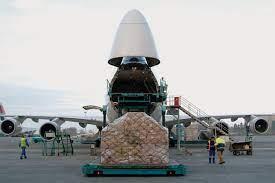Air Cargo Security and Screening Systems Market assessment of cost-effective solutions for small and medium airports

Air cargo security and screening systems market is evolving to address the unique needs of small and medium airports. Unlike major hubs with large budgets and advanced infrastructure, smaller airports often face financial constraints that limit their ability to invest in high-end screening systems. To overcome these challenges, operators are exploring cost-effective solutions that balance security, efficiency, and regulatory compliance. These solutions help smaller airports maintain global standards while managing operational costs and ensuring safe cargo handling.
Challenges for Small and Medium Airports
Small and medium airports often struggle with limited financial and human resources. High-end air cargo screening systems such as computed tomography (CT) scanners, AI-driven software, and automated conveyors can be prohibitively expensive. Additionally, training staff to operate advanced equipment adds to operational costs.
Another challenge is managing compliance with international regulations. Agencies such as the International Civil Aviation Organization (ICAO) and national authorities require strict adherence to safety standards, regardless of airport size. Smaller airports must therefore find solutions that allow them to meet regulatory requirements without overextending budgets.
Cost-Effective Screening Technologies
Several cost-effective technologies have emerged to help smaller airports maintain security standards. Compact X-ray systems, for example, offer reliable screening capabilities at a fraction of the cost of larger CT scanners. These systems are suitable for medium-sized cargo volumes while ensuring accurate detection of prohibited or hazardous items.
Dual-energy X-ray scanners provide another affordable option, allowing operators to differentiate between organic and inorganic materials efficiently. While these systems may not offer the advanced 3D imaging of high-end CT scanners, they provide sufficient capability to meet most regulatory requirements.
Role of AI and Software Solutions
Software solutions and AI-based platforms are increasingly being used as cost-effective alternatives to physical infrastructure. AI-powered image analysis can assist operators in detecting suspicious items using existing X-ray machines, reducing the need for additional hardware investments.
Predictive analytics and risk-based screening software help prioritize high-risk shipments, allowing staff to focus attention where it is most needed. This approach reduces the strain on human resources while improving efficiency and maintaining safety standards.
Outsourcing and Shared Services
Outsourcing is another effective strategy for small and medium airports. By partnering with specialized security providers, airports can access advanced screening capabilities without incurring the full cost of equipment or training. These providers offer trained personnel, certified equipment, and compliance expertise, allowing airports to meet regulatory requirements efficiently.
Some regions also implement shared service models, where multiple airports use centralized screening facilities. This collaborative approach reduces costs while ensuring consistent security standards across several airports.
Efficiency and Operational Benefits
Cost-effective solutions not only save money but also improve operational efficiency. Smaller airports often handle fluctuating cargo volumes, and scalable solutions allow them to adjust resources based on demand. For example, modular screening systems can be deployed during peak periods and reduced when traffic is lower, optimizing both staff and equipment usage.
Automated systems, even in smaller configurations, reduce the need for manual handling, minimize human error, and accelerate cargo processing. These efficiency gains are essential for maintaining competitiveness in a rapidly growing air cargo industry.
Compliance and Regulatory Advantages
Implementing cost-effective security solutions ensures that smaller airports remain compliant with both national and international standards. Compact and AI-integrated systems can generate audit trails, track inspections, and maintain documentation required for regulatory approvals.
This compliance is critical for airports that aim to participate in global supply chains. Airlines and logistics providers are more likely to operate through airports that demonstrate reliable security practices, even if the airport is smaller in scale.
Regional Adoption Trends
Small and medium airports in Asia-Pacific, Africa, and Latin America are increasingly adopting cost-effective air cargo security solutions. These regions are experiencing growth in air cargo traffic, driven by trade expansion and e-commerce. Affordable screening technologies enable airports to meet rising demand without exceeding budget limitations.
In developed regions such as Europe and North America, smaller airports are also leveraging AI-based platforms and shared service models to enhance security while optimizing costs. The trend reflects a global recognition that airport size should not compromise safety or compliance.
Future Outlook for Small and Medium Airports
The future of air cargo security at small and medium airports is closely linked to technological innovation and scalable solutions. Advancements in AI, predictive analytics, modular screening systems, and software integration will continue to provide cost-effective ways to enhance security.
Public-private partnerships and government funding programs are expected to support the deployment of advanced solutions in budget-constrained airports. These initiatives will allow smaller operators to maintain high safety standards, improve operational efficiency, and strengthen their role in global supply chains.
Conclusion
Small and medium airports face unique challenges in implementing air cargo security systems due to limited budgets, fluctuating cargo volumes, and regulatory requirements. Cost-effective solutions, including compact X-ray scanners, AI-powered platforms, outsourcing, and modular systems, provide practical ways to maintain safety, efficiency, and compliance.
By adopting these solutions, smaller airports can compete effectively in the growing global logistics industry, ensuring secure, reliable, and efficient cargo handling. As technology evolves, the accessibility of advanced screening solutions will continue to expand, enabling airports of all sizes to meet the demands of modern air cargo operations.
- Art
- Causes
- Crafts
- Dance
- Drinks
- Film
- Fitness
- Food
- Jeux
- Gardening
- Health
- Domicile
- Literature
- Music
- Networking
- Autre
- Party
- Religion
- Shopping
- Sports
- Theater
- Wellness


